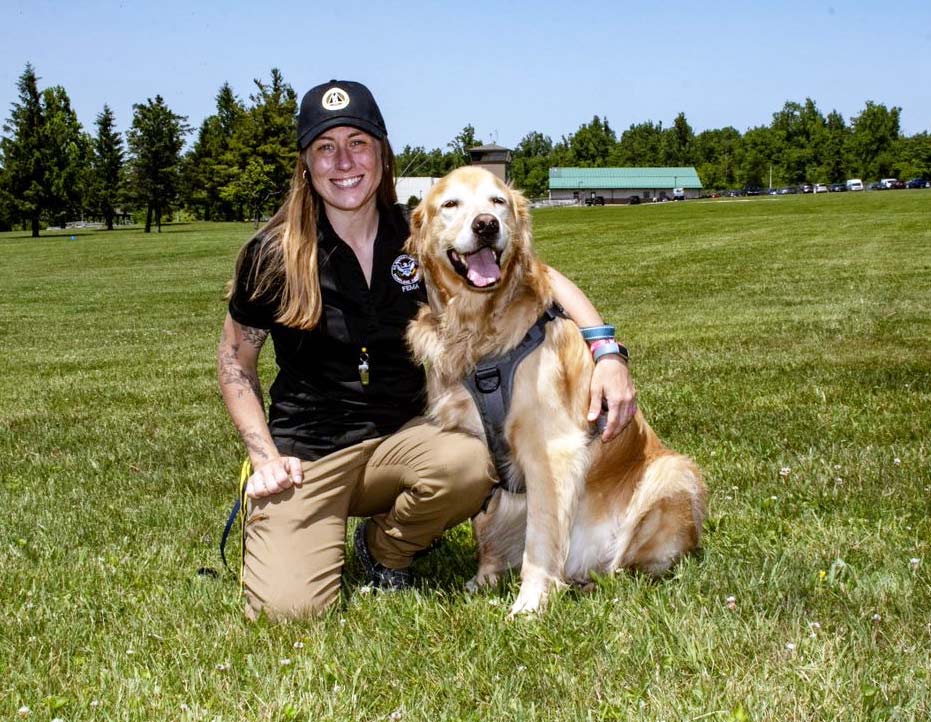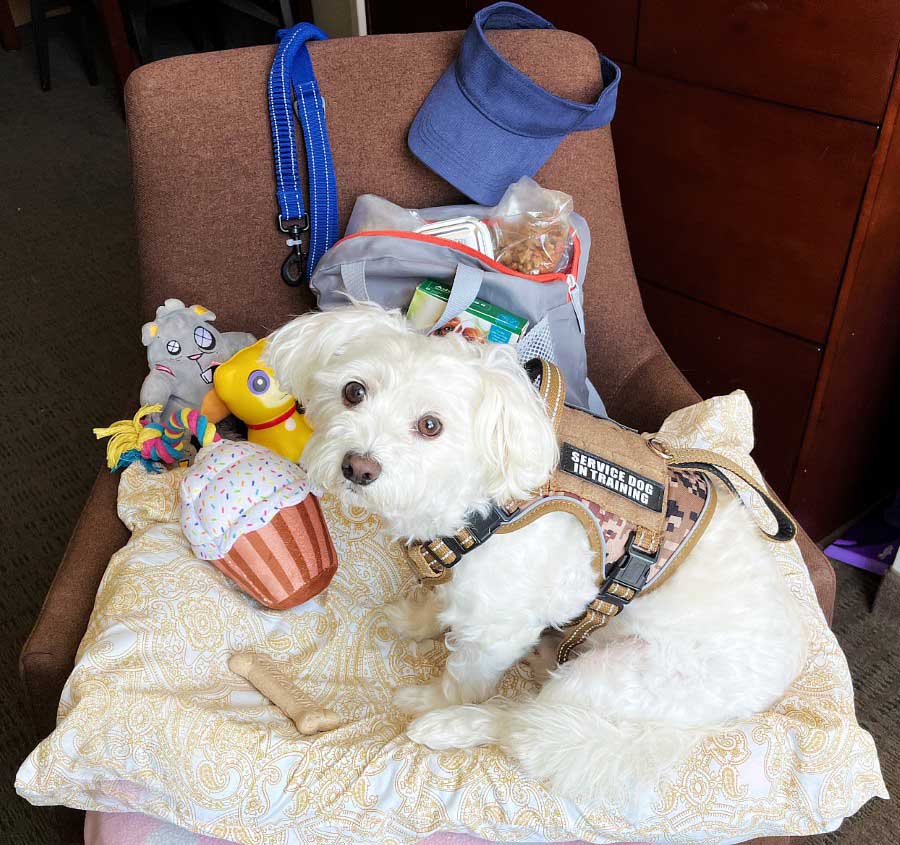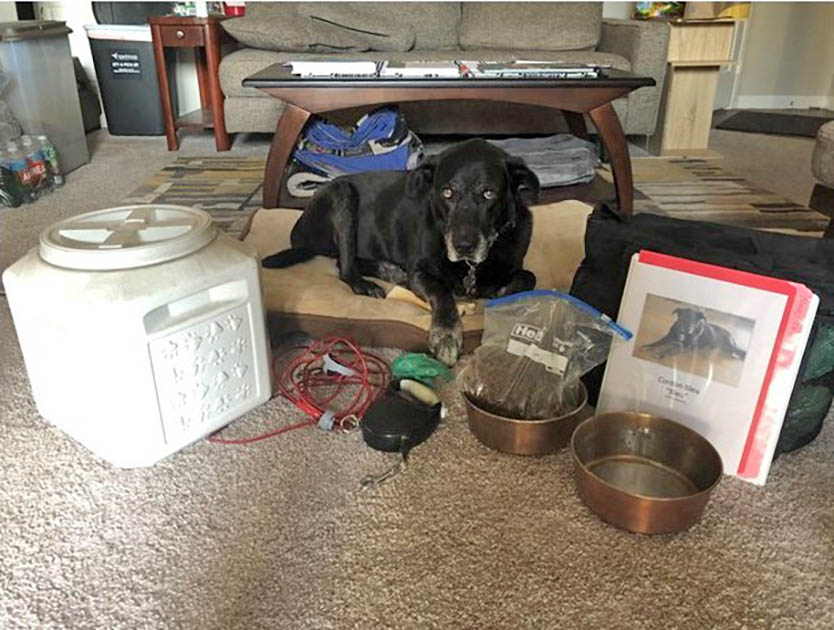Your pet is an important member of your family. To make sure that your pet is as ready for a disaster as you are, you should include them in your emergency plan. This means knowing how you will evacuate them and gathering the supplies they will need before a disaster happens.
FEMA employees shared some of what they do to make sure their pets are prepared.
Rick and Lucy

Submitted by Region 5 Program Analyst Emily Minkow. She cares for brother and sister Lakeland Terriers.
“Ricky and Lucy Minkow are ready to go, prepared for any emergency! But to be prepared, they like me to keep their carriers full of items like medication, food (especially treats), doggy bags and pictures of their humans. They love their doggy back packs as they have phone numbers, pictures of all of us, prescriptions, a folder of all their vaccinations, some food, treats, water and bowls.”
Submitted by Earthquake Programs and Communications Specialist Maigen Wise. She has a giant Golden Retriever named Hugh who works as a medical alert service animal.
Hugh

Submitted by Earthquake Programs and Communications Specialist Maigen Wise. She has a giant Golden Retriever named Hugh who works as a medical alert service animal.
“Hugh is my medical alert service animal and comes with me everywhere. So, I need to ensure he's always ready for anything. As part of Hugh's pet preparedness plan, I set up a shared folder with my family. This folder contains all of his important documents. Storing his files on a virtual platform allows us to access the information from anywhere at any time, giving me peace of mind knowing that I don't have to worry about finding paper files that could be lost or damaged.
“I have also created a tag for his collar with a QR code linking to a basic emergency information document in the shared folder. The contents of the folder include: food and supplements overview; Identification photos; medical clearance letters; microchip number and information; my emergency contact information; service animal licenses; training certification information; vet records (e.g., vaccines, tag numbers, visit records, etc.); federal approval letters, including his airline travel approval documentation from the Department of Transportation, reasonable accommodation approval from FEMA, and facility access approval letter from the U.S. Navy. Storing your pet's critical information in a shared digital folder is an easy and free step that anyone can add to their Pet's Preparedness Plan.”
DeeDee

Submitted by Disaster Survivor Assistant Karen Sandbeck. She cares for horses, dogs, pigs, cows, ducks, geese and cats.
“In high winds, I put them in pasture away from trees. In heavy rain, DeeDee goes to wood barn. In a cold freeze, DeeDee and her pals go to hay barn and stand next to large round bales to stay warm. In a drought, DeeDee has water from trough or goes to pasture with cows that has the most water. In a fire, she would be moved away by horse trailer so as not to have lung damage.”
Chester

Submitted by Skills Development and Innovative Education Specialist Feliciano Hurtado Jr.
“Apart from having an evacuation plan, extra food, medication, and supplies on hand; Chester and I take inventory of those items and replace anything that may be nearing expiration and conduct a maintenance check with all the gear to make sure everything is still good to go. Chester never forgets to check that his green froggy go-bag (pictured) is never running low on treats.”
Fred

Submitted by Region 3 Supervisory Emergency Management Specialist/Field Deployment Unit Supervisor Susan Thornton. Thornton has an American Foxhound named Fred.
“Fred has a go-bag ready at all times. Fred's go-bag consists of extra leash, collar, food for three days, toy treats to keep him calm, medication, pet first aid kit, wipes for his paws/fur, a blanket, a dog coat, dog booties and more. For long hikes, we have a carry out system for Fred in case he is injured. We make sure Fred is able to walk in the boots twice a year (so he doesn't stand still during a real emergency) and he wears coats often during the winter. It's cold in Pennsylvania! Also, I have worked hard to make sure that Fred is comfortable in the car for long periods of time. He's a road dog and loves deployments.”
Gusbert

Submitted by Branch Chief Emma Poon. Poon has a cat named Gusbert.
“I always keep Gusbert's carrier with a travel litter box, extra litter and food/water ready.”
Teddy

Submitted by Field Leadership Policy and Operations Analyst Lourd Daniel Tizon.
“Familiarizing multiple friends/family with your pet and their needs. Community is essential especially before, during and after an emergency!”
Harley

Submitted by External Affairs Program Liaison Laura Guzman, based at the Florida Joint Field Office. Guzman has a dog named Harley Davidson' Guzmán.
“Harley is always READY for any emergency! He keeps me company on the road when I'm deployed and makes survivors and co-workers smile. I make sure to keep his bag packed with prescription medicines, favorite toys, wet/dry food, blankies and plenty of treats. I also include harnesses, leashes, water and grooming supplies. Harley hopes that all dogs, cats and other critters are also kept safe and prepared, just like him. Arf!”
Bleu

Submitted by Region 8 Regional Exercise Officer David Ouimet. Ouimet said he makes sure his black-Labrador Retriever, Cordon Bleu "Bleu,” is ready for anything!
“I have a preparedness kit for Bleu, consisting of food, water, a bed, leash, doggie bags and a folder with all his medical information in it (and a picture of him on the front).”
Tucker

Submitted by Training Specialist Carley Swetz.
“Tucker has a go-bag ready with duplicates of all of his favorite things so he will not feel he is leaving them behind. Tucker has also practiced leaving for emergencies with his parents many times both indoors and outdoors. He loves to sniff his go kit often for the yummy food inside but gets nervous when he sees his clippers.”
For more information on how to prepare your pet, visit Prepare Your Pets for Disasters | Ready.gov.

